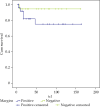Is perioperative brachytherapy effective in carcinoma of the tongue?
- PMID: 35233231
- PMCID: PMC8867236
- DOI: 10.5114/jcb.2022.113425
Is perioperative brachytherapy effective in carcinoma of the tongue?
Abstract
Purpose: To analyze the results of patients treated with perioperative interstitial brachytherapy (ISBT) in tongue carcinoma (TC).
Material and methods: From April 2009 to May 2015, 43 squamous cell carcinoma consecutive patients diagnosed with TC were treated with limited partial glossectomy and perioperative ISBT, using high-dose-rate (HDR). Twenty- seven patients were treated by brachytherapy (BT), and sixteen received BT as a complement to subsequent external beam radiotherapy (EBRT) after results of lymph node dissection. Median age was 66 years. Distribution by stage, included 10 patients stage I, 14 stage II, 10 stage III, and 9 stage IV. Eighteen patients had negative margins, nineteen margin involvement, and in six cases, the margin was < 5 mm.
Results: With a median follow-up of 54 months, LC at 3 and 5 years was 87% and 84%, respectively. LC was 95% at five years in patients with clear margins, and 75% with involved margins. LC in N0 patients treated with BT was 83% at 5 years, and in patients N+ with posterior EBRT treatment, LC was 86%. By tumor size, we found one local relapse in 13 cases T1, in 5 of 27 patients T2 was found, and no local relapse T3 with LC of 87%, 70%, and 100% respectively at five years. Regional control (RC) was 81% at 3 and 5 years. We found a metastasis-free survival of 91% at 3- and 5-year. Twenty-three patients have died, 11 of them due to other causes, with overall survival of 56% at three years and 53% at five years.
Conclusions: Combined treatment with conservative surgery and ISBT shows similar results to radical surgery or RT alone, allowing a more patient-tailored approach, with good organ function preservation and cosmetic outcomes.
Keywords: brachytherapy; high-dose-rate; perioperative; tongue carcinoma.
Copyright © 2022 Termedia.
Conflict of interest statement
The authors report no conflict of interest.
Figures





References
-
- Ganly I, Patel S, Shah J. Early-stage squamous cell cancer of the oral tongue–clinicopathologic features affecting outcome. Cancer 2012; 118: 101-111. - PubMed
-
- Preis M, Hadar T, Soudry TEet al. . Early tongue carcinoma: analysis of failure. Head Neck 2012; 34: 418-421. - PubMed
-
- Hinerman RW, Mendenhall WM, Morris CGet al. . Postoperative irradiation for squamous cell carcinoma of the oral cavity: 35-year experience. Head Neck 2004; 26: 984-994. - PubMed
-
- Iyer NG, Kim L, Nixon IJet al. . Outcome of patients with early T1 and T2 squamous cell carcinoma of the base of tongue managed by conventional surgery with adjuvant postoperative radiation. Head Neck 2013; 35: 999-1006. - PubMed
-
- Mazeron JJ, Ardiet JM, Haie-Meder Cet al. . GEC-ESTRO recommendations for brachytherapy for head and neck squamous cell carcinomas. Radiother Oncol 2009; 91: 150-156. - PubMed
LinkOut - more resources
Full Text Sources
Miscellaneous
